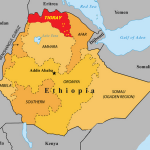 The first nation to be involved in the CASA – project is Ethiopia also by virtue of the historical relations between Italy and that nation. The Italian contribution has, indeed, proved one of the most significant in the ambit of the fight against poverty in Ethiopia, involving sectors of crucial importance, such as, education, energy and health services organization.
The first nation to be involved in the CASA – project is Ethiopia also by virtue of the historical relations between Italy and that nation. The Italian contribution has, indeed, proved one of the most significant in the ambit of the fight against poverty in Ethiopia, involving sectors of crucial importance, such as, education, energy and health services organization.
Communicable diseases (CDs), including tuberculosis (TB), malaria, HIV/AIDS, respiratory infections, diarrheal diseases and nutritional deficiencies contribute to the high disease burden in Ethiopia. HIV/AIDS is still one of the main health challenges to be faced. Although HIV prevalence is not very high, and the country recently experienced a major reduction in new HIV infections, it still has a large number of people living with HIV (PLWH): in 2014 (latest estimated data) the adult prevalence was 1.2 % [1.0%-1.5%], with an estimated 730,000 [600,000-970,000] PLHIV.
In line with other sub-Saharan countries, Ethiopia has been implementing numerous efficacious strategies to scale up antiretroviral therapy (ART) and improve the quality of HIV care. In 2003, the Government of Ethiopia introduced its ART programme with the goal of reducing HIV-related morbidity and mortality. In 2005, Ethiopia started to provide “free ART” with the support of the U.S. President’s emergency Program for AIDS Relief (PEPFAR) and the Global Fund.
In the third decade of the pandemic, despite numerous interventions in the fight against HIV/AIDS both by Government and global health initiatives, the challenges with reference to universal access to prevention, care and treatment are still huge.
This calls for a more robust and targeted response by Ethiopian Government, also because of the implementation of the new “World Health Organization (WHO) Guidelines” on “The Use of Antiretroviral Drugs for Treating and Preventing HIV Infection”, which will put the country in front of a renewed effort to reach their progressive implementation.
The implementation of the new WHO Guidelines ,”Treat All” regardless CD4 cell count, will mean that more people will start earlier . However, at the same time there is now a growing number of patients who have been on treatment for several years. This new scenario with unprecedented increase of diverse needs among the population of PLWH will further represent a new challenge for the health system.
According to the WHO Guidelines a differentiated care, which it is a client-centred approach that reflects the diversity of needs of people in care, should be supported to help countries and programme managers improve the quality and efficiency of services .
Because durable viral suppression is the key for sustained clinical benefit and reduced HIV transmission, innovative strategies to improve retention in care and adherence to treatment should be implemented.
The objective of CASA-project is to contribute to improve the quality of care of patients with HIV- infection in Tigray. The achievement of this objective needs a holistic approach including research, training, and the active involvement of patients’ Associations.


